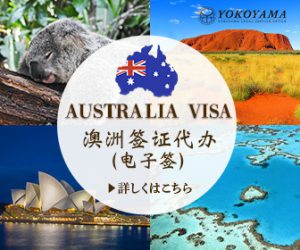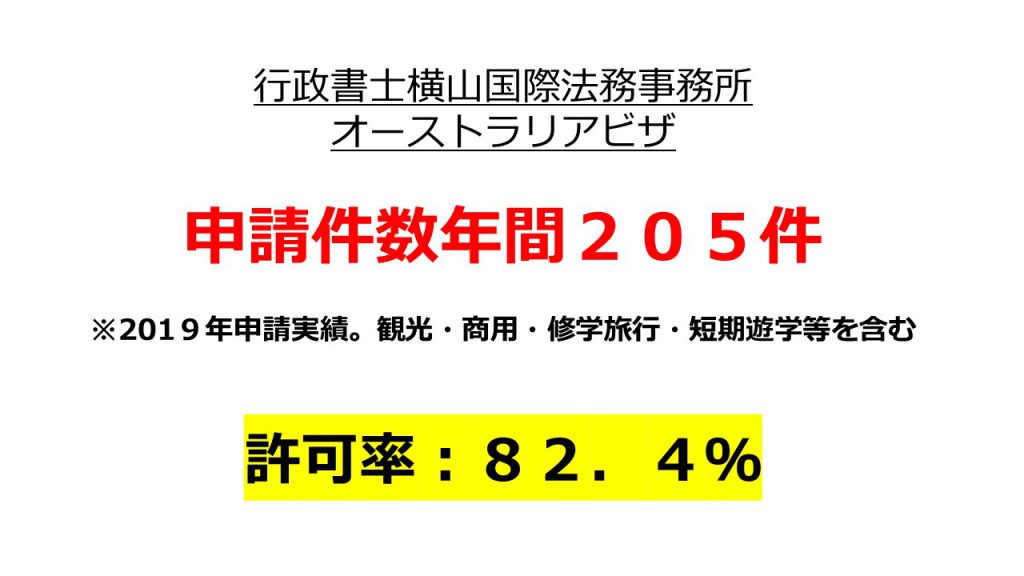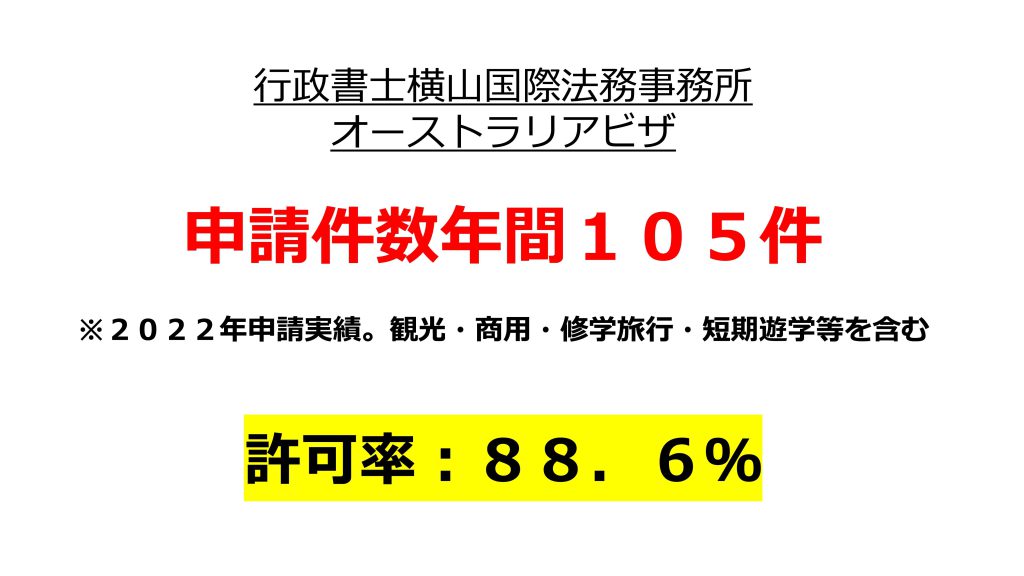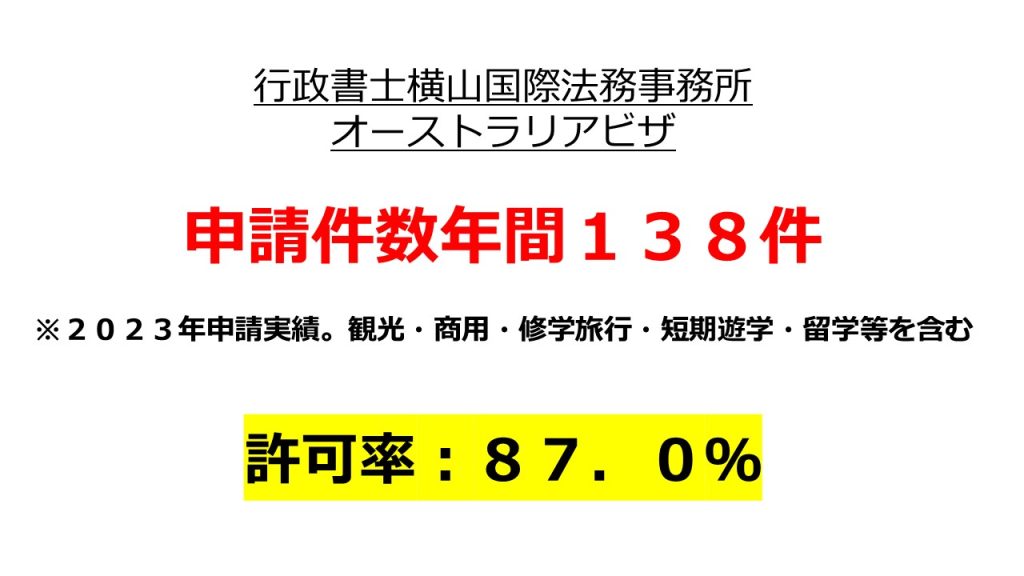コンテンツ
- Introduction
- 1. Who is this page for?
- 2. Visa type: Visitor visa (subclass 600) – Tourist stream
- 3. Application method: Online only, via ImmiAccount
- 4. Step-by-step: Applying for an Australia Tourist Visa from Japan
- Step 1 – Confirm the correct visa type
- Step 2 – Create your ImmiAccount
- Step 3 – Complete the online application form
- Step 4 – Upload your documents
- Step 5 – Pay the visa application charge
- Step 6 – Health examination (if required)
- 5. Typical documents required
- 6. When the applicant has no own income
- 7. Do I need to send my original passport?
- 8. Processing times
- 9. Common reasons for refusal (especially for South Asian applicants)
- 10. Travelling with children under 18
- 11. Typical profiles of South Asian clients we assist
- 12. Why use our office?
- (1) Less stress and time-saving
- (2) We serve clients all over Japan
- (3) Translation and visa support in one package
- (4) Experience and track record
- (5) Clear fee structure
- (6) Confidentiality and data protection
- 13. Contact us
(For people who currently live in Japan and apply from Japan, not from India, Pakistan, Bangladesh, Nepal, etc.)

Introduction
Hello, and thank you for visiting our page.
My name is Yokoyama, a licensed 行政書士 (gyoseishoshi – registered administrative legal specialist in Japan), and I run the Yokoyama Legal Service Office in Tokyo.
This page explains the procedure and required documents for South Asian passport holders living in Japan – including nationals of India, Pakistan, Bangladesh, Nepal and other countries in the region – who wish to travel to Australia as tourists and need to apply for an Australia Tourist Visa (Visitor visa, subclass 600 – Tourist stream) from Japan.
At present, the Australian Tourist Visa can only be applied for online, through the ImmiAccount system of the Australian Department of Home Affairs.
Paper applications and in-person submissions at the embassy or consulate are no longer accepted.
If you are not comfortable with:
English online forms,
scanning and uploading documents, or
translating Japanese documents into English,
you can leave the whole process to our office.
1. Who is this page for?
This page is intended for people who:
Do not hold Japanese nationality,
Currently live legally in Japan (you have a Residence Card), and
Plan to travel from Japan to Australia mainly for tourism or short visits.
Typical examples of passport holders who normally must obtain a visa before travelling include:
India
Pakistan
Bangladesh
Nepal
Sri Lanka
Afghanistan
Bhutan
Maldives
And also many other countries such as China, Vietnam, Thailand, Indonesia, the Philippines, etc.
Even if you are a Permanent Resident in Japan (永住者 / Permanent Resident), as long as your passport nationality is from a visa-required country, you still need to obtain an Australian visa before you travel.
By contrast, holders of passports such as:
Japan
United States
Hong Kong
Malaysia
Singapore
(in some cases) Taiwan
usually use an ETA (Electronic Travel Authority, subclass 601) via a mobile app, rather than the Visitor visa subclass 600.
In short:
The type of Australian visa you need is determined by the nationality of your passport, not only by your residence status in Japan.
2. Visa type: Visitor visa (subclass 600) – Tourist stream
The Visitor visa (subclass 600) – Tourist stream is generally suitable if you:
Travel to Australia for tourism, holidays, sightseeing,
Visit family members or relatives for a short stay,
Attend a short English language course (for example a few weeks or a couple of months),
Join school trips, homestay programs or study tours,
Take part in amateur sports competitions together with your team.
If your main purpose is business (meetings, conferences, trade visits, negotiations, etc.), the Business Visitor stream may be more appropriate, with different requirements.
Once your application is assessed, the Australian authorities may grant, for example:
A multiple-entry visa valid for about one year, or
A single-entry visa valid for one trip only.
This is decided purely by the Australian Department of Home Affairs based on your individual case.
3. Application method: Online only, via ImmiAccount
From Japan, all Tourist Visa applications are made:
100% online, using ImmiAccount.
The Australian embassy or consulate no longer accepts paper forms by post or over the counter.
Advantages of applying online:
You can apply from your home anywhere in Japan
You do not need to visit the embassy
No postage costs for documents
You can check the status of your application through ImmiAccount
However, many applicants find the process challenging because:
A computer and stable internet are required (doing everything on a smartphone is possible but not ideal),
All documents must be scanned and uploaded as PDF or images,
The visa fee must be paid by credit/debit card with international payment capability,
All forms, instructions and messages are in English.
If this feels stressful or confusing, you can ask our office to handle the entire online process on your behalf.
4. Step-by-step: Applying for an Australia Tourist Visa from Japan
Step 1 – Confirm the correct visa type
On the website of the Department of Home Affairs, there is a section called “Explore visa options”.
You will be asked to input:
Your nationality,
The purpose of your visit,
The intended length of stay in Australia.
Based on this, the system suggests suitable visas such as:
Visitor visa (subclass 600) – Tourist stream
Working Holiday visa (subclass 417)
Transit visa (subclass 771), etc.
Choosing the wrong visa type at the beginning can negatively affect your case, so this step is important.
Step 2 – Create your ImmiAccount
Next, you create an ImmiAccount, which will be used to:
Fill out and submit your online application form,
Upload all supporting documents,
Pay the visa application charge,
Receive automated e-mails including your Visa Grant Notice once a decision is made.
Step 3 – Complete the online application form
In the online form, you will be asked to provide information such as:
Personal details,
Family details,
Travel history,
Proposed travel plan in Australia (itinerary),
Employment situation and income in Japan,
Financial details to show you can cover the cost of your trip.
Step 4 – Upload your documents
All required documents are scanned and uploaded to ImmiAccount as PDF or image files.
You are not required to purchase flight tickets before applying for a tourist visa.
From a risk management perspective, it is usually safer to:
Apply for the visa first,
Purchase tickets after your visa is granted.
This helps you avoid losing money on non-refundable tickets if the visa is, in rare cases, refused.
Step 5 – Pay the visa application charge
After checking all the information, you pay the visa application charge with a credit or debit card that can be used for international online payments.
Please note that the Australian government does not refund the application charge, even if the visa is refused.
If we lodge the application on your behalf, our professional fee is also non-refundable, because the work is already performed.
Step 6 – Health examination (if required)
In some situations, the Australian authorities may require a medical examination, especially when:
You plan to stay more than 3 months, or
You are 75 years old or older.
If a health check is needed, it must be done at a panel clinic or hospital designated by the Australian government in Japan (for example in Tokyo, Osaka, Kobe, Fukuoka, Sapporo, etc.).
The clinic/hospital sends the result directly to the Australian side. After that, you simply wait for the final decision, which will be notified by e-mail.
5. Typical documents required
(for South Asian passport holders working or residing long-term in Japan)
The exact document list depends on your individual situation, but for a South Asian passport holder who works in Japan or who lives in Japan as a dependent (spouse, child) of a worker, the following are commonly requested:
Completed online application form (in English)
Proof of payment of the visa application charge (from ImmiAccount)
Recent digital photograph, passport size (35 x 45 mm)
Colour scan of your passport (ideally all pages, especially those with visas and stamps)
If available, scans of old passports showing travel history for the last 10 years
Colour scan of your Residence Card (front and back)
National ID card from your home country (if any)
Bank balance certificate showing current savings (in English or with English translation)
Travel itinerary in Australia (where you plan to stay and travel)
Jūminhyō (住民票 – certificate of residence in Japan) listing your household members, with English translation
A simple family list in English (parents, siblings, spouse, children, parents-in-law, etc.)
If your spouse is Japanese: copy of Koseki Tohon (戸籍謄本) with English translation
Certificate of employment and leave approval letter from your employer (in English)
Salary slips for the last 2–3 months (if only in Japanese, they should be translated into English)
Tax/income documents such as kazei shōmeisho (課税証明書) or gensenchōshūhyō (源泉徴収票) with English translation
Documents showing ownership of property or other assets (if relevant), with translation
Copies of the passports of any family members who will travel with you (spouse, children, etc.)
If the main applicant is under 18 years old or does not have their own income, additional documents will be required and the assessment will be more sensitive.
6. When the applicant has no own income
Typical situations include:
Full-time homemaker,
Student,
Person fully supported financially by spouse or parents.
In such cases, a financial sponsor is usually required, for example:
Your spouse, or
Your parents.
The sponsor will be expected to:
Provide a written statement confirming that they will cover all expenses of the trip, and
Submit their own financial documents (bank balance, salary, tax documents, etc.)
Our office prepares English templates similar to a Statutory Declaration, adjusted to Australian visa practice, and helps you structure this part correctly.
7. Do I need to send my original passport?
In most cases, no.
For online Tourist Visa applications lodged from Japan, it is usually not necessary to send your physical passport to the embassy or to our office.
Instead, you:
Scan the photo/details page of your passport in colour, and
Upload it through ImmiAccount together with other documents.
If your visa is granted, it will be issued as an electronic visa linked to your passport number.
Australia does not put a physical visa sticker into your passport.
You will receive a PDF file called a Visa Grant Notice by e-mail.
We recommend that you:
Print this PDF and carry it with you when you travel, and
Keep a digital copy on your smartphone, in case the airline or border officers ask to see it.
8. Processing times
Processing times vary, depending on:
The season,
The volume of applications being handled,
Your individual background and documents.
As a general reference:
Around 75% of applications are finalised within roughly 2–3 weeks,
Around 90% are finalised within about 1 month.
Some applications are decided faster, some take longer.
To stay on the safe side, we usually recommend:
Applying for your visa about 1.5 to 3 months before your intended departure date.
In many cases, it is also possible to apply up to around 1 year before your planned trip.
9. Common reasons for refusal (especially for South Asian applicants)
In some cases, the Australian authorities decide to refuse a visitor visa application.
Typical reasons include, for example:
Relatively short period of stay in Japan (lack of stability),
Short remaining validity of your residence status in Japan (for example, less than one year left),
Low income or insufficient savings,
Weak family or social ties in Japan (risk that you may not return),
Young applicants travelling alone, especially female,
Unstable employment history or current unemployment,
Nationality or profile assessed as higher migration risk,
Previous visa refusals in Australia or other countries,
Children under 18 travelling without sufficient parental consent documentation.
In such higher-risk cases, it is very important to:
Prepare a clear and logical cover letter / explanation letter, and
Provide additional supporting evidence (such as proof of stable employment, family ties, financial capacity, and reason to return to Japan).
Our office has experience with many “difficult” cases, including people who:
Have already had a visa refused before, but
Wish to re-apply with a stronger and better-prepared application.
10. Travelling with children under 18
The Australian government is very strict about minors (under 18 years old) entering and leaving the country.
If your child under 18 will travel:
Alone,
Only with the mother or only with the father, or
With relatives such as grandparents, uncles or aunts,
then the authorities will usually require:
Consent letters from the parents (from one or both parents, depending on legal custody and family situation),
Documents showing who has legal custody,
In some cases, specific forms such as Form 1257, completed by an adult in Australia (21 years or older) who will take responsibility for the child during their stay.
When we handle such cases, we:
Review the family law situation of your home country as necessary (India, Pakistan, Bangladesh, Nepal, etc.),
Check your marital status (married, separated, divorced, custody arrangements, etc.),
Determine who needs to sign which forms,
and help you prepare explanations in English so that the visa officer clearly understands your family situation.
11. Typical profiles of South Asian clients we assist
We regularly assist clients from India, Pakistan, Bangladesh, Nepal and other South Asian countries living in Japan, including:
IT engineers and other professionals working in Japan on work visas,
Their spouses and children applying for tourist visas together,
Parents visiting their children who are working or studying in Japan or Australia,
Couples where one partner is South Asian and the other is Japanese or from a third country,
Students and language-school attendees in Japan who want to visit Australia during holidays,
Families where children attend international schools or private schools in Japan.
Many of our South Asian clients:
Have strong technical backgrounds (especially IT),
Are familiar with English, but
Prefer professional support for dealing with immigration documents and risk management.
12. Why use our office?
(1) Less stress and time-saving
You do not need to communicate directly with the Australian authorities in English.
You can contact us in Japanese, English or Chinese.
We check your documents, prepare English explanations, complete the online form for you and manage the uploads and follow-up.
(2) We serve clients all over Japan
Our office is located in Tokyo (near Nihonbashi),
But many of our clients live in Kanagawa, Saitama, Chiba, Ibaraki, Shizuoka, Aichi, Osaka, Hyogo, Fukuoka and other prefectures.
In most cases, we handle everything by e-mail, phone and courier/post; you do not have to visit us in person.
(Please note: As a rule, we only accept cases where the applicant currently resides in Japan and holds a valid Japanese Residence Card. We generally do not handle applications from outside Japan.)
(3) Translation and visa support in one package
You do not need to search separately for translators.
We advise which Japanese documents need English translations, and we arrange translations that meet the expectations of Australian immigration.
(4) Experience and track record
We have been assisting with Australian visa applications for foreign residents in Japan since around 2016.
We handle roughly 100–200 cases per year.
Our overall approval rate is generally over 80%, even including a large number of complex and higher-risk cases.
(5) Clear fee structure
Exact fees depend on your situation, but as a rough reference:
Service for Australia Tourist Visa (Visitor visa – subclass 600) for foreign residents in Japan
Professional fee for our office: from around 55,000 JPY per main applicant (including basic translations of key documents)
Official visa application charge (Australian government fee): from around 26,000 JPY equivalent
If multiple family members apply together (for example, husband, wife and children):
We usually offer reduced professional fees for the second and subsequent applicants.
We will provide a written quotation after we receive your basic information (number of applicants, family structure, residence status in Japan, document volume, travel history, and complexity of your case).
Both the Australian government fee and our professional fee are non-refundable, even if the visa is refused, so we always aim to prepare your case as carefully as possible from the beginning.
(6) Confidentiality and data protection
During a visa application, you must share highly sensitive information such as:
Passport details,
Residence Card details,
Income and tax documents,
Bank balances and financial information,
Family information and addresses.
As a licensed gyoseishoshi office in Japan (行政書士事務所), we are legally bound by a strict duty of confidentiality (守秘義務).
We handle your documents and personal data with great care and in compliance with Japanese law.
13. Contact us

If you are a South Asian passport holder living in Japan – for example from India, Pakistan, Bangladesh, Nepal, Sri Lanka or other countries in the region – and you:
Want to visit Australia for tourism or holidays,
Plan to visit children, relatives or friends in Australia, or
Wish to attend a short English course in Australia,
we are ready to assist you with your Australia Tourist Visa (Visitor visa – subclass 600) application from Japan.
Yokoyama Legal Service Office
Phone: 03-6264-9388
E-mail: info@lawoffice-yokoyama.com
You can contact us in Japanese, English or Chinese.
After we learn about your situation, we will propose the most suitable way for you to apply for an Australia Tourist Visa from Japan as a South Asian passport holder.

オーストラリアビザ実績2019

オーストラリアビザ実績 2022年

オーストラリアビザ実績 2023年

オーストラリアビザ実績 2024年
![JAPAN VISA [YOKOYAMA LEGAL SERVICE OFFICE]](https://lawoffice-yokoyama.com/wp/wp-content/uploads/2014/10/logo_024.png)
